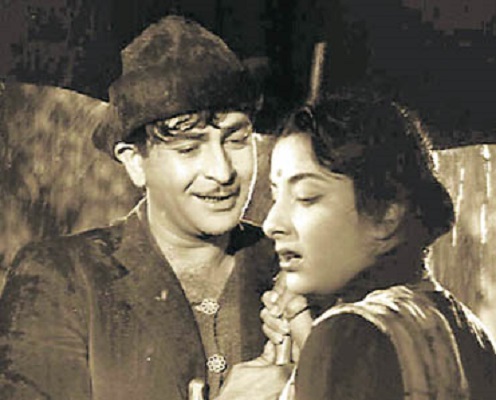In a scene from the hit film Shree 420, Ranbir ( Raj Kapoor ) tells a shy Vidya ( Nargis ) while seated on the bench of the ‘footpath palace hotel’ “Ek sharif ladke ko jab ek sharif ladki se pyaar ho jaaye toh unhe shaadi kar leni chahiye”. Kapoor is gently holding Nargis’ hands as she twitches and turns every which way. Moments later it starts to rain and the two break into the iconic ‘Pyaar hua ikraar hua hai’. The song is of course an iconic tune from the early era of Hindi cinema, and it idolises a perfect life – love, family and happily ever after. Peeved by the rain, Nargis has no option but to share an umbrella with Kapoor, at which moment she looks overwhelmed, knotted at the stomach by a bittersweet force she can neither resist nor fully enjoy. It’s that precise moment where rain, metaphorically, replaces the sexuality of the two. The fact that this song is preceded by Kapoor talking about ‘Sharafat’ is indicative of the way Hindi cinema pioneered the art of hiding sensuality and sexuality in plain sight. Years later, Doordarshan would use the same song for a condom advisory between ad breaks.
As a burgeoning film industry, film viewing until recently, was still viewed as an unnecessary indulgence, a vice that only louts and loafers would indulge in. It’s a perception that the industry has not only fought with outsiders, but also with people within the industry who struggled to accrue the respect that their popularity signalled. The two aren’t always the same. Because cinema is really a heightened, more aggressive form of reality, it was a conundrum to a nation repopulating itself with fury, how to talk about sexuality without seeming depraved? Bollywood as is evidence found other means, methods that would conceal yet reveal, rather tastefully, the act of copulation that though widespread was considered a moral abrogation. Hence was born the rain dance sequence.
In Chalti ka Naam Gaadi (1958), Kishore Kumar sings about a ‘Ek ladki bheegi bhaagi si’. It’s naughtier than before and hints as the isolation required to mate. India has always been nuclear in terms of familial structures, which also implied a lack of privacy . The rain, therefore, became a metaphor for some potentially hazardous, but ultimately rewarding isolation out in the open. When people ran indoors to hide, maybe it was the time for lovelorn couples to seek corners and nooks. The colour era of cinema couldn’t avoid the dramatic duplicity of the rain song either . ‘Bheegi Bheegi Raaton Mei’ from Ajnabee(1974) sees both Rajesh Khanna and Zeenat Amaan perform what was perhaps as close to eroticising the relationship between a man and women we had come to. The protagonists grab, claw and even pretend to bite. They fall on each other, rub skin against skin in what is a cathartic expression of somewhat ungainly sensuality.
Some of Hindi cinema’s most iconic songs have been framed within the derivate freedoms of the monsoon. From Sridevi in ‘Lagi aaj Sawan’ to Raveena Tandon in ‘Tip Tip Barsa Pani’, Hindi cinema has methodically found alternatives to conveying sexuality. The only problem with the late, more ecstatic versions of the trope is the objectification of its women. The humbling tenderness of years ago gave way to a more a more uproarious, salacious way of declaration. We went from poetry to prose. Bollywood is not known to be deeply intuitive about moral boundaries, and so it used the rain dance to itemise the presence of sexuality in our films rather than generalise it. The sexual innuendo of the rain dance thus became an event rather than a casually installed lived reality. Sexuality went from hush hush metaphors to full blown melodrama, in repudiation to which sanskar returned to our cinema in the 90s with a vengeance. Not just sex, even love became compliant, yearning for a life under the guidance of the elders.
Bollywood’s grammar has often been ridiculed for how hammily it painted a picture of intimacy – flowers kissing, lamps turning off, or the camera simply choosing to look outside the window. But in all honesty, to a help a conservative audience comprehend a world full of sensual delights, cinema did in its own crooked, incomprehensive ways find alternatives. The rain song was both eulogised and butchered, not to mention yielded to sexism to unfortunate effects much later. It might look tacky and dated today but given cinema’s reputation as the first real challenge to moral uniformity, Hindi cinema did achieve a certain level of poesy. Some of the most iconic roles in Hindi cinema have been donned not by its men necessarily, but women who were unafraid to strut their lust and desire. It came at some cost to most, but cinema assisted in its own way by regularly turning to motifs that though indirect, alluded to the things we as a society did not want to talk about. Ironically, half of the time, the rain manufactured too.
The author writes on art and culture, cinema, books, and everything in between. Views expressed are personal.
Read all the Latest News , Trending News , Cricket News , Bollywood News , India News and Entertainment News here. Follow us on Facebook , Twitter and Instagram
)